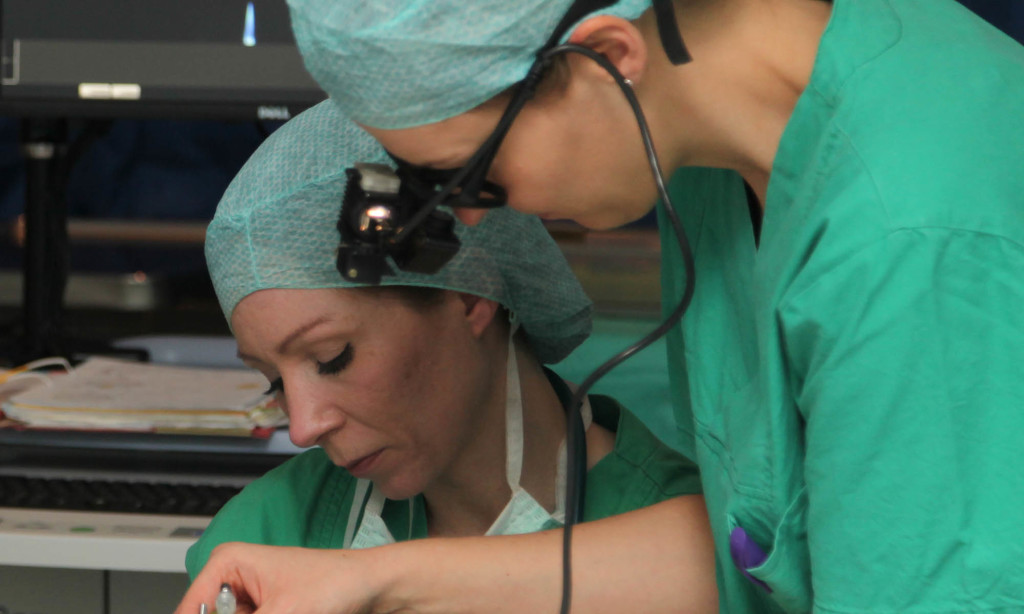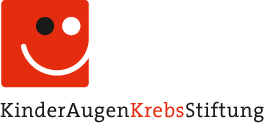Research and Mission

Mission of KAKS in Research
The KAKS has set itself the goal of promoting retinoblastoma research – why? There is no commercial interest in this rare disease, and scientists also find it easier to obtain funding for common cancers such as breast cancer or prostate cancer.
Since its foundation, the KAKS has initiated, financed, accompanied and completed various retinoblastoma research projects – in each case in search of new therapies, diagnostic methods or aftercare.
To date, KAKS has been particularly successful in providing funding at three levels:
- Therapeutic and diagnostic approaches for retinoblastoma that originate from successfully completed or ongoing studies of other types of cancer (see e.g. CAR-T cell project);
- Projects that are promising, but still too small for the big pots (e.g. DFG, DKS, EU)
- Projects that cannot wait for long approval procedures. These are reviewed by the KAKS at short notice and, if approved by the evaluators, financed on an interim basis.
Various KAKS projects have thus laid the foundations for major German and EU studies.
For further information or collaboration, please do not hesitate to contact us. info@kinderaugenkrebsstiftung.de
[/accordion_item]Projekt 1
CAR T Cell application in Retinoblastoma
– Dr. med Annette Künkele – Charité, University Medicine Berlin, Prof. Dr. Ulrich Schraermeyer – University Hospital Tübinge
In the KAKS project described below, CAR-T cells were able to destroy tumour cells so successfully that an in vivo study is now being started in Tübingen. The CAR-T cells from Berlin will be used in a mouse model at the University Hospital in Tübingen. The mouse model originates from the project “Prevention of radiotherapy induced secondary tumours in retinoblastoma animal models” initiated by the KAKS several years ago (see below). The KAKS has brought the two groups together so that the research can now be continued seamlessly and cost-effectively.
Genetic modification of CAR-T cells for use against retinoblastoma cells
With this project, KAKS has opened up one of the most promising tumour research fields for the field of retinoblastoma. Here the immune system of patients is artificially armed with T cells – the armed T cells are called CAR-T cells. CAR stands for “chimeric antigen receptor”. This is, as the name suggests, a chimera between antibody and T-cell receptor, i.e. a mixture of two surface structures that are formed in the human body by different immune cells and help these immune cells to perform different functions. Through the antibody component, the CAR-T cell can specifically recognise surface proteins, so-called antigens, on cancer cells, while the T cell receptor component enables it to destroy the antigen-presenting cancer cell. In our case, the antigen-presenting cancer cell is a retinoblastoma cell. Since tumor cells can generally be able to escape CAR-T cells by downregulating these typical antigens (so-called antigen loss), in this project we investigated the use of different CARs that recognize two different antigens. This “double attack” was intended to pre-empt the antigen loss. On the one hand we used a CAR that recognizes the retinoblastoma typical antigen GD2, on the other hand we used a CAR that recognizes the antigen CD171, also known as L1CAM. In preliminary work, our group has shown for the first time that CD171 is found on the surface of retinoblastoma cell lines. As a result, CARs were developed against GD2 and CD171 with different extra- and intracellular domains, and lentivirally introduced into T cells and the resulting CAR-T cells were functionally tested in vitro against different retinoblastoma cell lines.
Initiated and sponsored by KAKS
Projekt 2
Liquid Biopsy for Early diagnosis I
– Charite Berlin and University Hospital Essen
Research on the early detection of cancer by blood analysis (“Liquid Biopsy”) has made enormous progress in recent years: experts speak of “revolution” and “breakthrough” in early cancer detection. The KAKS is in the midst of two tumor marker projects (Berlin and Amsterdam).
Blood analysis was tackled by the KAKS at a very early stage as a central research objective. For the early detection of retinoblastomas and secondary tumours in blood samples, three approaches were initially attempted: 1. antibodies against retinoblastoma components, 2. retinoblastoma markers, 3. tumour cells circulating in the blood. These approaches have been researched with the support of Bild e.V. Ein Herz für Kinder and the KAKS at the Max Planck Institute in Potsdam and the UK-Essen. Certain cancer marker proteins could be detected for the retinoblastoma in the test tube.
However, these experiments did not show the necessary sensitivity in the blood for the antibodies and the tumour cells.
As a result, the project at the Charité in Berlin was expanded to include the latest highly sensitive “Liquid Biopsy” technologies for the analysis of tumour DNA in the blood. Again, with the support of Bild e.V., we are currently funding a doctoral thesis that uses these completely new technologies.
After a very special processing of the blood, a so-called hybrid-capture sequencing assay is used to specifically examine certain genes for characteristic changes. In addition to the retinoblastoma gene RB1, the genes most frequently altered in secondary tumours are also considered. With the available genomics/DNA sequencing data sequencing data in public databases and in the scientific literature all known changes are determined and evaluated with bioinformatic methods in order to be able to recognize the DNA, which is characteristic for such secondary tumors, in the blood.
In parallel approaches, the DNA tests are then tested on the blood of retinoblastoma patients and various secondary tumor types as well as on healthy people for comparison. Recently, a comparable technique was used to detect 8 different tumours in 98% of patients. The doctoral thesis, which is currently dealing with the compilation of the relevant genes, is oriented towards this.
Initiated by KAKS, sponsored by KAKS and Bild hilft e.V. – Ein Herz für Kinder
Projekt 3
Liquid Biopsy for Early diagnosis II / EU Project
Another large Liquid Biopsy project in which KAKS is involved is the EU Era-net Transcan tumor marker project, which is funded by the European Union with more than EUR 1 million. Also in this project the KAKS was able to fulfil its self-imposed task of providing start-up financing by financing part of the preparatory work at the Free University of Amsterdam (VumC) and by also being able to incorporate results and material from the above KAKS tumour marker project at the UK-Essen. The group of Prof. Dr. Petra Temming, who carried out a large part of the early marker research, is also involved in the EU project. The EU-funded tumor marker project started in 2018 with universities from four countries as part of a major research collaboration. We are proud that we were able to contribute to the preparatory work for this important project and are now funding the integration of tumor data from the various national tumor centers. In general, research on the early detection of cancer by blood analysis (“Liquid Biopsy”) has made enormous progress in recent years: experts speak of “revolution” and “breakthrough” in early cancer detection. The KAKS is right in the middle with two tumor marker projects (Berlin and Amsterdam).
Projekt 4
Prevention of radiotherapy induced secondary tumours in retinoblastoma animal models
– Dr. Sylvie Julien, Prof. Dr. Ulrich Schraermeyer, Prof. Dr. H. Peter Rodemann – University Clinic Tübingen, Germany
First stage: Development of a new Animal model
Second stage: Testing the radioprotective effect of p-Tyrosin in the animal
model
Status: Completed.
Publication https://www.ncbi.nlm.nih.gov/pubmed/27694105Initiiert von KAKS und gefördert von der Deutschen Kinderkrebsstiftung
Abstract
Sponsor: Deutsche KinderkrebsStiftung and KinderAugenKrebsStiftung
Projekt 5
Innovative treatment options in transgenic and orthotopic animal models
– University Clinic Essen, Germany – PD Dr. rer. nat. Alexander Schramm
Chemotherapy with only one active ingredient is not promising since the
RB-tumors build up resistance quickly. Chemotherapy with multiple active
ingredients can be applied to reduce tumor size in order to then apply
laser- thermal- or cryo-therapy. However chemotherapy has significant side
effects. The study aims at testing various chemotherapeutics in cell culture
and animal models and identifying the mechanisms of resistance. In addition,
the substance beta-Lapachon from the bark of the lapacho tree is tested
Sponsor: Deutsche Kinderkrebsstiftung and KinderAugenKrebsStiftung
Projekt 6
Late effects study
– Prof. Bornfeld, Prof. Lohmann
The KinderAugenKrebsStiftung is co-sponsor of a DKS study that intends to
optimize long-term support and improvement of long-term prognosis and life
quality of RB-cancer survivors. The long-term effects of different therapies
were identified with respect to the second tumor risk including individual
genetic disposition. In addition, patients and parents were taught
preventative measures. In the first phase the children and adolescent’s
collective was 570 patients]
Sponsor: Deutsche Kinderkrebsstiftung and KinderAugenKrebsStiftung
Projekt 7
Analysis of the Diagnosis Pathway
– University Clinic Essen, Germany
This study has been completed. It had the goal to analyse the diagnosis
pathway of children affected by retinoblastoma in order to improve early
diagnosis. The results show that the most frequent first symptoms are
leukokoria and cross-eyedness. First symptoms are mostly recognised by
parents and often not diagnosed or misinterpreted by pediatricians even
though the children frequently visit pediatricians in the first months of
their lives. For the study data of 1049 patients between 1992 and 2011 were
analysed. This study also shows that the delay until diagnosis has not
significantly changed in the last 20 years.
We have various projects that are intended to change this situation. The
White eye campaign tackles the problem by disseminating symptom information
to parents and paediatricians. The smart phone white eye detector app is
aimed at the same goal and presently we are starting an educational program
for all paediatricians.
Status: completed
Sponsor: KinderAugenKrebsStiftung
More here:
http://www.KinderAugenKrebsStiftung.de/wpcontent/uploads/2014/02/WilmDGKJ2013pdf.pdf)
Projekt 8
Establishing a cell culture model for differentiation of mural retina from
stem cells
– UK Essen, Germany – Dr. Laura Steenpass, Dr. Petra Temming, Dr. Deniz Kanber
In retinoblastoma cells both copies of the RB1 gene are in activated. This
however is not sufficient to transform the cells into tumor cells. Thus far
it is unclear which molecular mechanisms contribute to tumor occurrence.
In order to find out more about these mechanisms and the primary
retinoblastoma cell, a model with stem cells is to be developed in order to
make available the initial retinoblastoma tissue for further testing. The
effects of different mutations on the development of the retina will then be
analysed to understand the cancer better.
Sponsor: KinderAugenKrebsStiftung
Projekt 9
Retinoblastoma-Inhibitors in Tumor Cell-lines
– University Clinic Essen, Germany – Dr. Temming
Aim of this project is testing promising tumor inhibitors SYK, PLK1 and BET
Bromodomain inhibitors in various retinoblastoma cell lines. In addition the
inhibitors are be tested in osteosarcoma cell lines as an example of a
common second tumor of Rb patients. The data generated are being used for
further development of clinical candidates.
Status: First positive results are available and are being used for further
studies
Sponsor: KinderAugenKrebsStiftung
